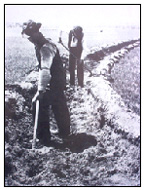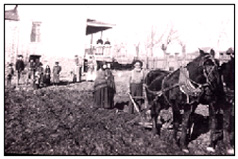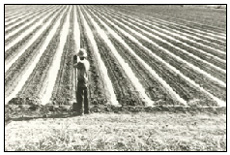An Essay
Pioneers of '47–Pioneer Irrigators
LeRoy W. Hooton, Jr.
July 22, 1999
Reposted July 18th, 2007
|
Colonizing the arid West
The average precipitation in the Salt Lake valley is about 16 inches, with very little of this during the summer growing season. Statewide the average is 14 inches, making Utah the second driest in the nation. The Mormon Pioneers had no experience with Utah's aridity, therefore, they had to develop a system of artificial irrigation and land management that not only allowed them to survive, but to grow and prosper. Others would emulate their success in irrigation in the arid West.
William E. Smythe, author and advocate for western reclamation, promoted the Mormon Pioneers’ success in his quest to reclaim the arid West. He was a national spokesman for developing the arid lands west of the hundredth meridian\1. East of this line there is generally adequate rainfall to grow crops, west of the line there is insufficient rainfall to grow crops. Smythe touted the early Mormon Pioneers’ successful irrigation efforts in reclaiming the Great Basin. In his book entitled "The Conquest of Arid America," published in 1900, he described the Mormon settlers as "[the]…pioneer irrigators of the United States." He believed that the West could be reclaimed by irrigation as practiced by the Mormon Pioneers. He writes, "…when studied in connection with Mormon colonization, it is plain that the [irrigation] system was born of the necessities of the place and time--that it is the legitimate product of the peculiar environment of the arid region. The forces that have made the civilization of Utah will make the civilization of western America."
A monolithic people
Elwood Mead, Chief of Irrigation for the US Department of Agriculture, noted in his "1903 Investigation Report" that the Mormon Pioneers settled a region that was thousands of miles from the nearest settlements on the east and almost as far from the California settlements on the west. Moreover, this isolated region was surrounded by what was considered almost impassable desert. Under these extreme conditions, it required an extraordinary people to survive and prosper. Perhaps this is where the Mormon Pioneers distinguished themselves from others. The practice of irrigation was the tool to conquer the land, but in order for it to work, it required the unequivocal discipline and cooperation of the faithful. Without both, most likely the Mormon settlement in the desert would have failed -- and history altered.
Mead noted that the Mormon Church had an enormous influence in settling the Great Basin. "In the early years of the settlement there was no provision for acquiring legal titles to either land or water, and without the supervision of the church authorities, acting as arbiters and advisors, there would have been no rule except that of forced." He also, observed that the Mormon Pioneers were "welded together" in their enthusiasm and cooperation in this new land. They built their stockade, dug their ditches and planted and harvested their crops as a monolithic people, bound by their religion and faith in their leaders. It is well recognized that the Church influence provided the cohesiveness and discipline necessary to successfully conquer the desert and sustain a large population.
Brigham Young was the ecclesiastical leader and the High Council performed the secular administration functions. The ward bishops acted as the chief magistrates or mayors within each of the wards. They organized and carried out the policy decisions. Water control and management were under the direction of each ward bishop. The residents of each ward were directed by the ward bishop to construct ditches to carry the water to each block within the wards. The ward bishops set water turns and settled disputes. On the larger canals that provided water to many wards, Brigham Young and the High Council would do the planning, but the actual work was delegated to the ward bishops, who assembled the ward members to do their assigned work in the construction of these facilities.
Water control within the city was transferred to the municipal authorities after Salt Lake City was incorporated in 1851. Elsewhere within the 210,000 square miles of the Great Basin, settlements were established under the direction of Brigham Young. Favorable town sites were selected and surveyed into square blocks, allotting city lots and farming lands to the settlers. The Pioneer brethren with their families were assigned to these new settlements to dig ditches, till the soil and plant crops. Tradesmen likewise were assigned to the new settlements to make them self-sustaining. In this manner 365 colonies were established in the Great Basin, gaining Brigham Young the title of the "Colonizer" or "America's Moses."
Pioneer water and land policies
|
Smythe credited Brigham Young's success in settling the Great Basin on his departure from large farm size that was typical in the East to smaller ones in the new settlements. In 1850 the average farm size in the United States was over 200 acres, whereas the pioneer farms were usually 10 acres or less. Furthermore, his policy was that land and water were allocated based on one’s ability to beneficially use them, rather than acquiring more land than could be used for speculation and profit. Smythe further speculates that given limited water and land, Brigham Young had to leave enough "to accommodate the thousands of ([sic]emigrants) whom he expected to follow him in the early future."
A major departure from early water law was the right to use water. Brigham Young established an important legal precedent for Western water law by abandoning the English “riparian rights” and adopting the doctrine of “prior appropriations for beneficial use.” The former granted landowners boarding water courses the right to the water. The latter establishes a principle of “first in time, first in right”; the first appropriator of canyon streams acquired rights to as much water as could be beneficially used.
The Bureau of Reclamation estimated that by 1865, the Mormon Pioneers had built diversion dams and dug ditches and canals that transported water to 1.5 million acres of grain and vegetables. "Fired with religious zeal and dedication, the Mormons undertook a remarkable transformation of the desert." By 1865 they had constructed 1,000 miles of canals. The population in Utah continued to increase from 65,000 Latter-Day Saints to 280,000 in 1900.
|
The 1902 Reclamation Act
National interest between 1878 to 1902 to develop the West created political interest in the Mormon Pioneer's irrigation experience. The Mormon success made the region the center of irrigation knowledge. Reclamationists across the country touted the Mormon successes in irrigation. The first National Irrigation Congress met in Salt Lake City in September 1891. The meeting was attended by those interested in developing the West and its resources. The meeting's key resolution asked Congress to grant states and territories needful of irrigation part of the public domain for the purpose of developing irrigation to render the lands then arid, fertile and capable of supporting a population.
In 1890, ninety percent of the population resided within the eastern half of the United States and less than 10 percent within the western half. It was estimated that 64 million people lived in the East and only a scant 4 to 5 million in the West. However there was growing pressure to settle the West. America had already invested in the nation's roads, river navigation, harbors, canals and railroads, making the case for Reclamationists to lobby the federal government for reclaiming the western half of the country by undertaking storage and irrigation projects. By 1890, the irrigation movement had gained enough strength to have pro-irrigation planks in both parties' platforms. Legislation was drafted by Nevada Congressman Francis G. Newlands and supported by President Theodore Roosevelt who was sympathetic to the West. On June 17, 1902 Congress passed the Reclamation Act. The Act required that water users repay construction costs for projects from which they received benefit.
The Mormon Pioneer experience played an important part in reclaiming the West. This is articulated through the words of Marc Reisner, author of the 1986 book entitled, "Cadillac Desert." He writes of the early Utah irrigation and farming efforts, "Without realizing it, they were laying the foundation of the most ambitious desert civilization the world has seen. In the New World … the Mormons attacked the desert full-bore, flooded it, subverted its dreadful indifference--moralized it -- until they had made a Mesopotamia in America between the valleys of the Green River and middle Snake." He continued, "In …1902 the United States government launched its own irrigation program, based on Mormon experience, guided by Mormon laws, run largely by Mormons.
The 1902 Reclamation Act developed irrigation systems in reclaiming arid lands in the 17 western states west of the hundredth meridian. The Bureau of Reclamation built 600 dams and reservoirs providing irrigation water for 9.2 million acres of land and drinking water for over 31 million people. These projects also generate electrical power serving six million homes. Federal reclamation made both the lands east and west of the hundredth meridian parts of the strongest and richest nation on earth.
With the passage of the 1902 Reclamation Act Utah's irrigation legacy would continue into next the century. The early success of irrigation by the Mormon Pioneers would continue under the federal reclamation program. Beginning with the Strawberry Project in 1907 through the Central Utah Project, 240,000 acre-feet of municipal and industrial water has been developed serving nearly a million people; and 430,000 acre-feet of irrigation water for irrigating 330,000 acres of farmland. The Bureau of Reclamation has spent over $2.3 billion in constructing 14 projects including 22 dams, counting the Central Utah Project as three projects. In 1935, Salt Lake City formed the Metropolitan Water District of Salt Lake City to repay the federal government for its share of the Provo River Project and Deer Creek Reservoir, providing the city an invaluable water supply for generations to come.
The population of the West has grown to about 86 million with the aid of reclamation projects, making it about one-third the population of the United States. This is an enormous increase from the estimated 5 million people in 1890. California has the largest population in the nation with 32 million inhabitants. Water development and irrigation has made it possible to sustain these populations within the 17 Western states.
Changing times -- changing attitudes
|
Modern agriculture provides an abundance of food for America and surpluses are exported around the world. In Utah farmlands are rapidly disappearing near the growing urban areas. Much of the farmland along the Wasatch Front is being urbanized as development replaces the once life-sustaining agricultural producing fields. Canal company stockholders sell their water to developers as their fields are subdivided. Brigham Young’s vision of agricultural self sufficiency is vanishing.
Despite contemporary thinking, we should not forsake our history. On this 24th of July, we should remember our ancestors’ struggle and labor to survive in this harsh land bordering the Great Basin desert -- and their contribution to the building of the West and a greater America. Their contribution should not be viewed in today’s terms, but in the context of the pioneer era when irrigation and agricultural successes built the West. Nearly all of the water developed first by the Mormon Pioneers and later by the Bureau of Reclamation provide us our municipal drinking water today.
_________________________________
\1 The hundredth meridian bisects the United States on a line running north to south passing through points west of Wichita, Kansas; Oklahoma City, Oklahoma; and Fort Worth, Texas. West of the hundredth median are the seventeen states of Texas, Oklahoma, Kansas, Nebraska, South Dakota, North Dakota, Montana, Wyoming, Colorado, New Mexico, Arizona, Utah, Idaho, Washington, Oregon, Nevada and California which are the arid states affected by the 1902 Reclamation Act.
Selected References
Water for the West - The Bureau of Reclamation 1902-1977, Michael C. Robinson
The Conquest of Arid American, William E. Smythe, Harper & Brothers Publishers, 1900
U.S. Department of Agriculture, Bulletin No. 124, "Report of Irrigation Investigations in Utah," Elwood Mead, Washington Government Printing Office, 1903
Bureau of Reclamation, http:www.usbr.gov/ "The Bureau of Reclamation - A Brief History
Cadillac Desert, The American West And Its Disappearing Water, Marc Reisner, Penguin Books, 1986
Brigham Young the Colonizer, Milton R. Hunter, Peregrine Smith Inc. Santa Barbara & Salt Lake City, 1973
Questions regarding this article can be directed by e-mail to: leroy.hooton@ci.slc.ut.us



